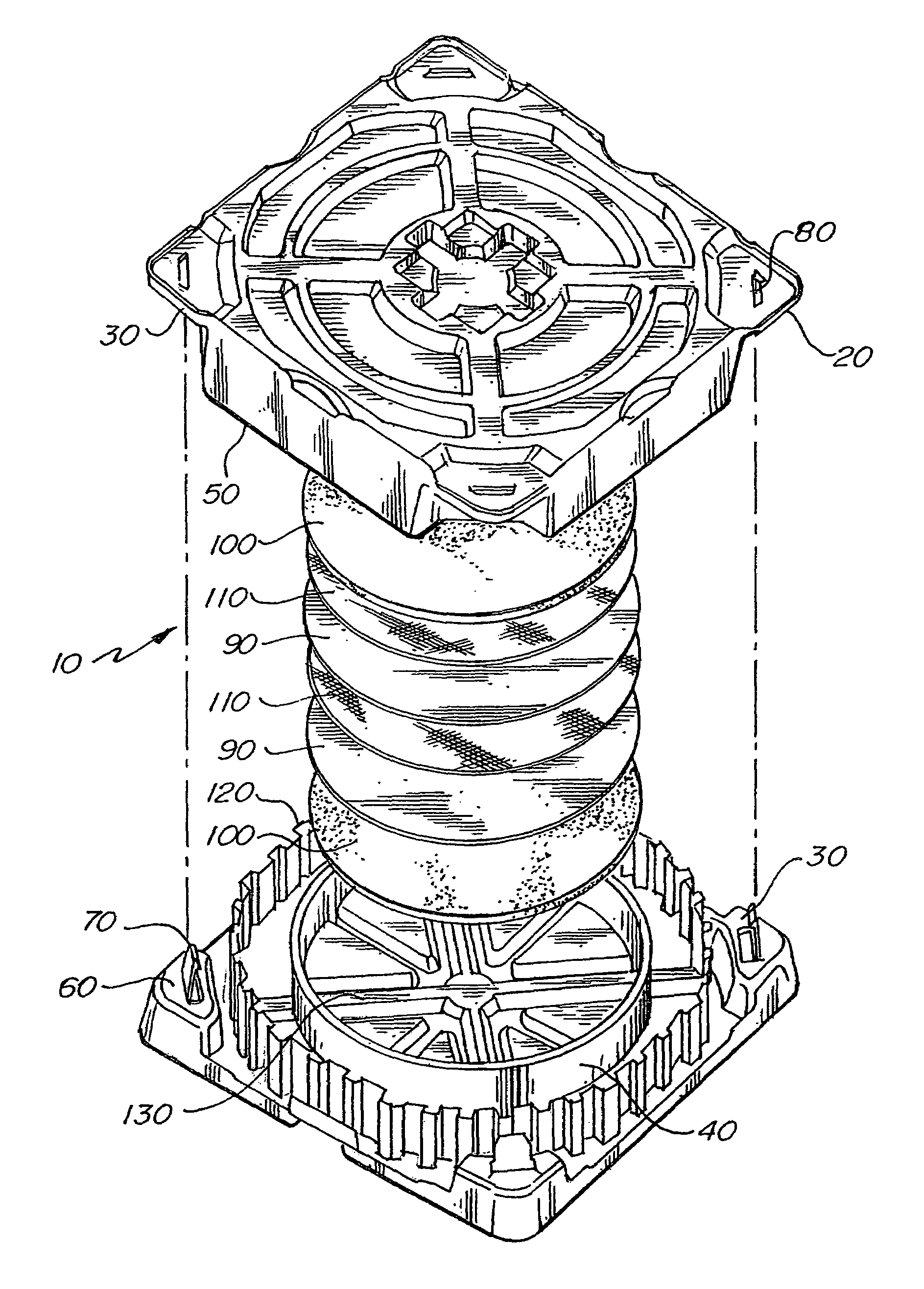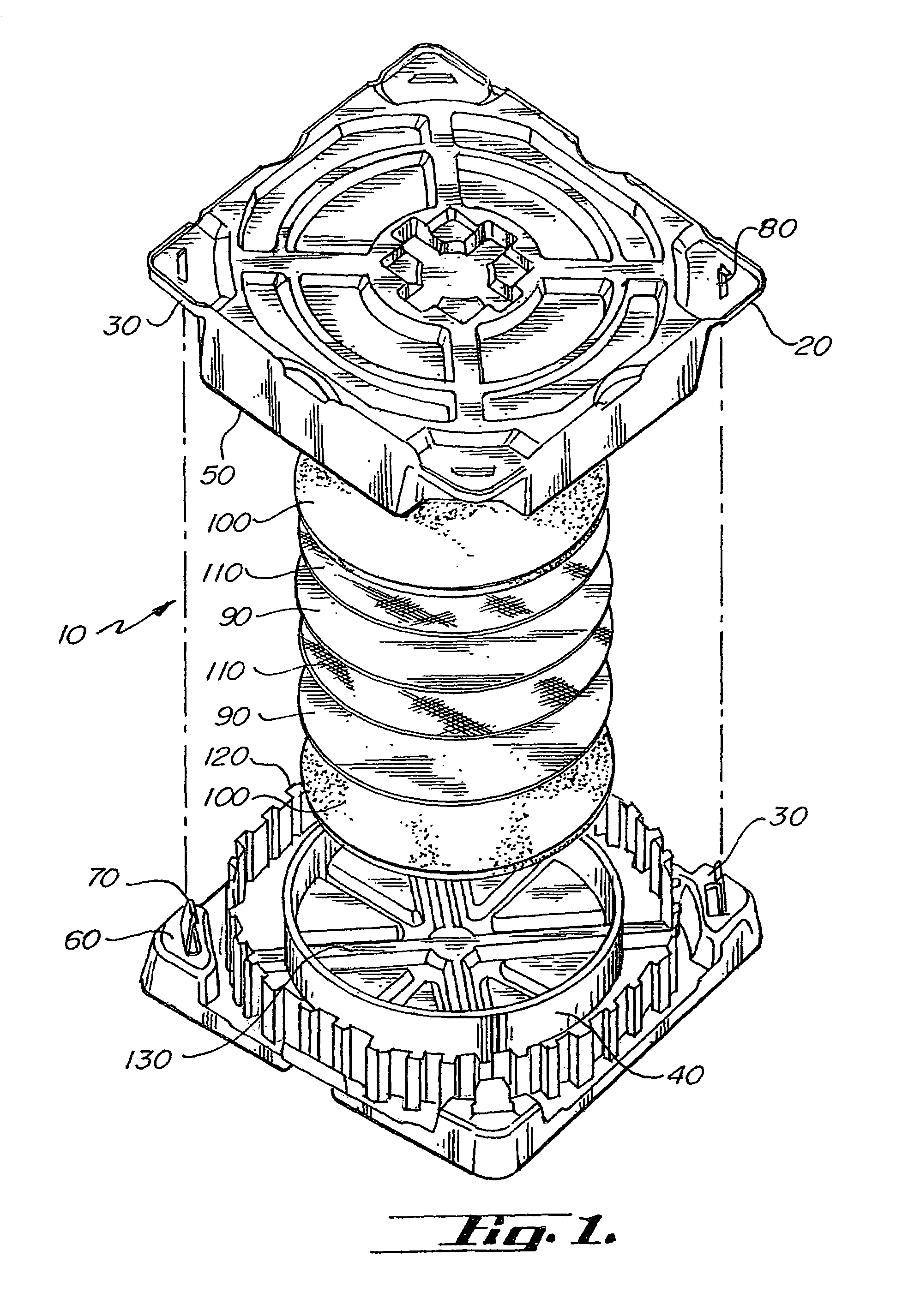System for cushioning wafer in wafer carrier
- Summary
- Abstract
- Description
- Claims
- Application Information
AI Technical Summary
Benefits of technology
Problems solved by technology
Method used
Image
Examples
example 1
Procedures for Testing for Ion Release Under Moderate Conditions
[0027]This example details the testing for ion release under moderate conditions. The method leaches materials with ultra-pure DI water for anion and cation analysis by ion chromatography.
[0028]The tests were performed using: Re-pipetter (RAININ) and corresponding tips or equivalent; Class 100 Laminar Flow Hood; PRECISION 180 Series Hot Water Bath or equivalent; Lead Ring Weights; 125-ml Polypropylene (PP) sample bottles; 18-MW / cm deionized water; 1000 ppm standards of fluoride, acetate, formate, chloride, nitrite, bromide, nitrate, sulfate, phthalate, phosphate, lithium, ammonium, sodium, potassium, magnesium, and calcium. “ppb” is defined as one nanogram per milliliter, (μg / ml); “ppm” is defined as one microgram per milliliter, (μg / ml). Clean class 10 nitrile gloves are worn while performing this procedure and as much sample preparation as was reasonably possible was performed in the class 100 laminar flow hood. All d...
example 2
Results of Testing for Ion Release Under Moderate Conditions
[0031]The procedures of example 1 were followed while analyzing multiple materials, including the following four materials: closed cell static-controlled polyethylene (PLASTAZOTE from ZOTEFOAM incorporated, Surrey, England); open cell anti-static polyurethane; corrugated conductive anti-static closed cell cross-linked high density crosslinked polyethylene; and closed cell anti-static polyethylene (CELLUPLANK). The results are tabulated in Table 1. Significantly, only one material provided less than 1800 ng / g Cl−, 400 ng / g F− / Acetate, 270 ng / g NO3−, 350 ng / g SO42−, and 60 ng / g PO43− ions leachable under moderate conditions.
[0032]
TABLE 1Results for Foam TestingHighLeachedClosed cellOpendensityClosed cellIonspolyethylenecellpoly-polyethyleneng / gPLASTAZOTEpolyurethaneethyleneCELLUPLANKCl−1600200042007200F- / Acetate220850150097000NO3−210220280approx 2500SO42−300370370approx 2500PO43−11050000OutgassedAminesAmines presentorganicspr...
example 3
Organic Outgassing Analysis by Gas-Chromatography-Mass Spectrometry
[0033]This example details procedures for measuring organic outgassing under stringent conditions. The method uses an automated thermal desorbtion unit (ATD) and analyzed via gas-chromatography-mass spectrometry (GC-MS). See also Thermal Desorbtion Gas Chromatograph, FGTM 1350. The following materials are required: Automatic Thermal Desorbtion Unit; Thermal Desorbtion Sample Tubes (glass); Thermal Desorbtion Sample Tubes (stainless steel) (SUPELCO P / N 255055); Thermal Desorbtion Sample Tubes (glass) (SUPELCO P / N 25090-U); 500 ppm heptane in methanol certified standard Gasoline Range Organic Standard. The following definitions apply: ppb is one nanogram per milliliter, (ng / ml); ppm is one microgram per milliliter, (μmg / ml). Note: Always wear clean Class 10 nitrile gloves while performing this procedure.
[0034]Personnel proceed as follows for equipment and sample preparation: Place a stainless steel ATD tube on the bala...
PUM
 Login to View More
Login to View More Abstract
Description
Claims
Application Information
 Login to View More
Login to View More - R&D
- Intellectual Property
- Life Sciences
- Materials
- Tech Scout
- Unparalleled Data Quality
- Higher Quality Content
- 60% Fewer Hallucinations
Browse by: Latest US Patents, China's latest patents, Technical Efficacy Thesaurus, Application Domain, Technology Topic, Popular Technical Reports.
© 2025 PatSnap. All rights reserved.Legal|Privacy policy|Modern Slavery Act Transparency Statement|Sitemap|About US| Contact US: help@patsnap.com



